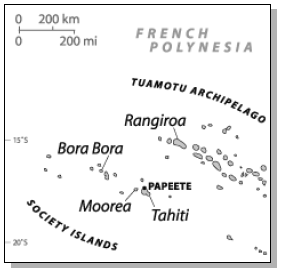The Tahiti AggressorContents of this Issue: Electronic Shark Repellent Vindicated Is Your Liveaboard Trip Aboard a Safe Vessel? Part I How SARS Can Ruin Your Dive Trip ... Even If You Donít Have It Want to Buy a Tropical Timeshare? Editorial Office: Ben Davison Publisher and Editor Undercurrent 3020 Bridgeway, Suite 102 Sausalito, CA 94965 in search of the pearls of French Polynesia from the May, 2003 issue of Undercurrent
Dear Fellow Diver: When it comes to sightseeing, a checkout dive is usually a throwaway, only good for checking out gear and getting accustomed to getting wet. Not this one. I was 90 feet down at a site called Aquarium, making sure my gear was in working order, when 30 feet above me a 14-foot giant hammerhead rolled over the top of the reef and swept down to 15 feet in front of me. Bigger than any hammer I'd seen at Cocos Island, it generated 10 electrifying seconds I'll never forget. So mesmerized was I that I never took a single picture. As he disappeared below, I turned to see my grinning buddies making appreciative hammer signs with their fists on their heads. While I swam with sharks on every dive, there's a lot more to Rangiroa diving. Fish were colorful and plentiful. Though soft corals were rare, hard corals were extraordinary -- one good reason Howard and Michelle Hall shot plenty of footage here for their new IMAX film, Coral Reef Adventure. On my checkout dive I also approached lots of butterfly fish, some vigorously raiding the nests of Titan triggers. A few anemones were home to Clarke's anemone fish. Large Napoleon wrasse knew how to stay just out of close-up photo range. Another photographer and I sandwiched a hawksbill turtle, snapping shots of the turtle and each other as we swam alongside. As I ascended, I joined several divers following Karen, the photo pro. While hovering at 15 feet, she inflated a huge safety sausage and floated it to the surface. As we finished our safety stop, the Aggressor's skiff pulled up. I hung on one of the lines that ran along both sides of the skiff while the Tahitian deckhand, Steve, took my camera and fins. It was an easy climb up the ladder into the skiff. One woman who had had a knee replacement didn't want to make the climb fully loaded, so she slipped out of her BCD, and Steve hauled it in and helped her up the ladder. The Tahiti Aggressor is the former Fiji Aggressor, a 106-foot, 18-passenger catamaran. In January she was filled to capacity with two New Zealanders, 14 Americans, and two engineers who were on board to repair air conditioning and refrigeration systems. Nine spacious double occupancy staterooms each contain a private bath and marine head, a large double bed, an upper bunk, and generous storage space. The rooms have individual air-conditioning controls, but a couple of nights our cabin didn't cool fully -- although the engineers aboard worked swiftly to solve problems. One morning our marine head stopped up, but the crew repaired it quickly. Each night the Aggressor crossed the open sea for a new venue for the next
day's diving. While the ship is stable, when the cat's hull slammed on the waves,
the sound vibrated throughout, especially in the forward cabins. Noise wasn't the
only problem. Fortunately, I'd brought Antivert (Meclazine), a prescription seasickness medication. Captain Paul's initial briefing covered ship safety, the amenities, and diving procedures. He urged us to carry a DiveAlert, a safety sausage, reflector mirror, and strobe, all of which they could provide gratis, as well as reef hooks. Divemaster Pierre advised us to stay above 130 feet, to mind our computers, and to make safety stops, as the nearest decompression chamber is an hour's flight away in Papeete. Because currents can reach a mask-ripping nine knots, Pierre reminded us in each briefing to stay with our guide so we wouldn't pop up all over the ocean and be hidden by swells. Pierre, who has dived this area all his life, previously owned a Tahitian dive shop, but said he found it too stressful. So he joined the Aggressor crew. All diving is from the aluminum skiff that sits across the Aggressor's stern. Sixteen divers, three guides, and two crew members boarded the skiff before it was lowered into the water. (All gear is left on the skiff between dives.) Pierre slipped behind each diver to check that air was turned on, and his assistant Steve offered a bucket of water and shampoo for mask defogging. On site everyone stood up paratrooper-style, ready for the giant stride through the skiff's side doors. With experienced divers this went well, and everyone was in the water quickly. The crew handed down cameras, having learned quickly which camera belonged to which diver. Water temperature was a consistent 82-84 degrees, visibility 50-100 feet, and the air comfortably tropical. The Tahiti Aggressor has three different itineraries -- Rangiroa, Moorea, and Bora Bora. My trip was a one-hour flight north of Papeete to Rangiroa in the Tuamotu chain. I made three distinctly different types of dives. The Aquarium was a typical reef dive, with the group drifting at 60-100 feet in one direction and then returning along the reef at 20-30 feet. Corner dives were made on slight or slack currents on reef edges near the passes. Then there were Rangiroa's world-class pass dives. For these thrill rides, the skiff dropped us outside the atoll on an incoming current, and we rode along, stopping more or less together for the exciting shark encounters. At Tiputi Pass, a well-known site, Pierre led the way to the plateau at 60 feet. While drifting along I noticed one diver in the five-knot current "running" much faster than he could ever have run on land. At 90 feet, I found a sturdy rock outcropping, placed my hook, and let out the three-foot cord -- I had attached it to my BCD -- until the current pulled me horizontal. Now I could observe the sharks without being swept off. We were about 40 feet from the sharks, who effortlessly swam back and forth, feeding in the current running through the pass. While too distant for good photography, in 100-foot visibility the viewing was great. After 10 minutes, I hauled in my hook and joined the other divers gliding with the current. I shot through several small 10-15 foot canyons, moving ever faster as the currents were compressed between the walls. We all hooked up again for more viewing, but sometimes the current was strong enough to make it difficult to pull myself back to the hook, especially since I needed one hand for my camera. Pass diving with sharks is a world class experience, but with so many divers in the water blowing bubbles the sharks stayed too far away for good photo and video opportunities. To plan the dive day, the crew first reviewed tidal times to find the fastest current, so we would see the most sharks. They selected reef and corner dive times around the pass dives. Tiputi's Shark Cave turned up empty because, they say, so many divers visit that the sharks have left. Our group hooked the plateau in front of the cave to watch the impressive parade of reef and black tip sharks. We made another stop with the reef hooks at the end of the pass for more reef and black tip sharks, mostly in the 6-8 foot size but still too far away to make good images with my 20- 35mm zoom lens. We unhooked and worked slowly up toward the surface, continuing to ride the current, forming three small groups, each with a staff member as we headed for our safety stops. Each dive guide again filled an orange sausage and sent it to the surface to attract the dive skiff crew's attention. When the skiff arrived, we surfaced as a group to avoid waiting on the surface and bobbing in the 3-4 foot waves. I had a Ranger BCD with back inflation compartments that I find difficult to manage on the surface with any sort of wave action. Stepping onto the
Aggressor's deck, I had my
choice of two fresh water
showers, shampoo provided.
Rinse tanks for skins and wet suits were separate from the camera
rinse tanks. Cameras were carefully
removed by the crew, rinsed, and returned
to the two two-level camera tables. I
used British-made Bendy Arms for my twin
flash. The sundeck is half covered, so after a dive I could warm up in the sun, then cool down in the shade. There is also the obligatory Aggressor hot tub, but I have never seen one in operation, and I've been on all but two Aggressors. If it had been filled, the water would have sloshed out during the night crossings. Beside CDs, videos, and DVDs, the library has a "take one, leave one policy" for books. There is a remarkable photograph of a tiger shark on the Tahiti Aggressor -- the image of a lifetime for some lucky photographer. Doms, the French cook, and his assistant prepared delicious meals. Since the first dive was at 7 a.m., they started serving breakfast at 6 a.m., and coffee and toast were available earlier. Eggs or omelets were quickly prepared to my specifications. Pancakes, French toast, bacon, and sausage were offered along with hot and cold cereals. Lunches were real meals including fish and chicken, not the cold sandwich or canned soup that many operators provide. At most dinners they offered two entrees: chicken, Australian beef, New Zealand lamb or turkey, sometimes mahi-mahi (one could order a bit of both), and plenty of fresh vegetables. The chef's fresh French bread and good sauces complemented his culinary efforts.Doms's assistant is a pastry chef and graced us with Bananas Foster and Chocolate Mousse. George and Steve served the meals, continually refilled our glasses, and cleared our places. Sodas were on tap. French wine and local beer were gratis. The guests were not the only well-fed participants on this trip. Pierre -- while doing a great impersonation of a matador -- hand-fed chicken to several 8-10 foot silvertips. I learned to situate myself at one end of the string of spectators to keep divers and bubbles out of my photos. Pierre held a piece of chicken and as each shark closed in, he would snatch the chicken away and hold it behind his back. Pierre admitted that once he had not paid attention to a 10-foot silvertip, and the shark had hit him, crushing three of his ribs. He says to watch for the nictitating membrane over the eye. "If the shark keeps the membrane open, he is not going to bite, and it is safe to pull the bait away," Pierre explained. "But if he closes the membrane, let him have the bait." While we saw many sharks during the day (often 50 to 100 at a time) -- black tip, reef, lemon, giant hammerhead, silky, silvertip, and even tiger sharks -- the really big ones, including tigers and oceanic white tips, come up at night to feed. But alas, they offer no night dives. There is the risk of someone being swept away and becoming impossible to find at night. Furthermore, each night the boat moves to a new venue, up to 10 hours away. So I spent my evenings in the spacious lounge watching slide shows or videos, telling tall tales on reading great books. 
The resourcefulness of the Aggressor staff became evident on a dive outside Farakava. I had a little flutter in my second stage as I descended, but it subsided so I continued. I love the patterns of Tridacna clams and settled in to take a few shots. My Aladdin air-integrated computer said I had 1850 psi, but the computer was telling me to go up because I had only two minutes left in my dive time. I swam to Marci, showed her my blinking computer, and motioned that I'd stay in her neighborhood. I went back to my happy clam when I got that you-just-sucked-yourtank- dry sensation. My gauge read 1800 psi. Thirty feet away, Mark, my cabin mate, was motioning for me to come see something. I gave him the out-of-air sign -- once, twice, three times -- as I swam over and went for his octopus. Still unaware I was out of air, he continued pointing at a nudibranch. Marci, who had kept an eye on me, arrived and we interlocked our right arms and ascended to 15 feet. We stopped and she ran up her orange sausage. The skiff showed up as we completed the safety stop. Onboard, Pierre disassembled my second stage and found that it was blocked with debris. We later returned to the entrance to Tiputi Pass for a corner dive on an outgoing tide. Pierre warned us not to enter the pass because if we were swept away the next boat we'd see would be the Kona Aggressor. We lined up and quickly jumped single-file into the water. As usual Pierre led the way, Karen was in the middle of the pack, and Marci was rear sweeper. With no current, we spread out in search of Tiputi's treasures. The Titan triggers were not nesting so were not aggressive. One had a green string hanging out of his mouth. I chased him around for five minutes and then moved on to a huge school of pink tail trigger fish. One look and I knew my TTL and A settings were in for a battle. Their bodies are dark and their tails are a translucent pink. As I finished with the pink tail triggers along the reef top at 20 feet, I was down to 500 psi and swam out from the reef for my safety stop. I surfaced alone, unable to see the skiff in the 2-3 foot swells. I sounded my Dive Alert, which generated a few laughs from the crew aboard the skiff, since they were only 20 feet behind me. They had eased up as they watched my bubbles during the safety stop. Along the green hard corals and rocky reef top, I'd frequently see dark blue tangs, domino damsels, schooling four bar convict fish, lionfish, unicorn fish, schooling Moorish Idols, parrotfish, schools of jacks, juvenile sweet lips so hyperactive they might have had attention deficit disorder, and fire gobies dancing from their sandy holes. I spotted a nice, marble grouper between two hard corals with a cleaner wrasse and at Aktapi a 5-foot goliath grouper darted out past my dive buddy when he looked under a rocky ledge. Often, a 5-foot barracuda hovered under the stern between the catamaran floats. We fed it chicken; it obliged by taking the pieces slow enough for still photos with its mouth open. In the open ocean and currents, beside the sharks, there were schools of Pacific barracuda, mantas, eagle rays, trevally, and unicorn fish. Frequently we heard dolphins, and they often escorted the skiff back to the Aggressor. On one pass dive, I saw Doms petting three bottlenose dolphins at once. Compared with Cocos Island, the number of shark and manta encounters were similar, but -- because of the concentration of divers and bubbles and the distance to the sharks from where one hooks to the reef -- the encounters are at a distance. You may not go home with as many good images as you bargained for. After our charter, I returned to Papeete with my dive buddy and took a bus to town to visit the market. I had hoped to buy a famed Tahitian pearl for my wife, but the prices were greater than those I had found in the U.S. My wife had to settle for pictures of the true Tahitian treasures, those I found underwater.
|

I want to get all the stories! Tell me how I can become an Undercurrent Online Member and get online access to all the articles of Undercurrent as well as thousands of first hand reports on dive operations world-wide
| Home | Online Members Area | My Account |
Login
|
Join
|
| Travel Index |
Dive Resort & Liveaboard Reviews
|
Featured Reports
|
Recent
Issues
|
Back Issues
|
|
Dive Gear
Index
|
Health/Safety Index
|
Environment & Misc.
Index
|
Seasonal Planner
|
Blogs
|
Free Articles
|
Book Picks
|
News
|
|
Special Offers
|
RSS
|
FAQ
|
About Us
|
Contact Us
|
Links
|
3020 Bridgeway, Ste 102, Sausalito, Ca 94965
All rights reserved.

 One passenger
turned down my offer to share my Antivert
the first night, but readily accepted
each subsequent night.
One passenger
turned down my offer to share my Antivert
the first night, but readily accepted
each subsequent night. The crew seemed familiar with
them and never handled the camera by the
arms. (For the pass dives, Bendy Arms
provided great frustration, so I used
ULCS arms that held my twin flash out
two feet on each side.) Karen helped
several guests improve their photos with
recommendations about flash positioning,
angles for taking images, and so on.
Her E-6 processing was excellent.
The crew seemed familiar with
them and never handled the camera by the
arms. (For the pass dives, Bendy Arms
provided great frustration, so I used
ULCS arms that held my twin flash out
two feet on each side.) Karen helped
several guests improve their photos with
recommendations about flash positioning,
angles for taking images, and so on.
Her E-6 processing was excellent.  Diver's Compass: The Aggressor website,
Diver's Compass: The Aggressor website, 